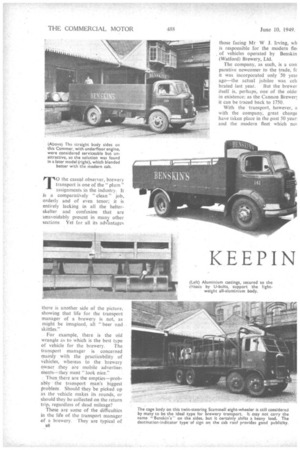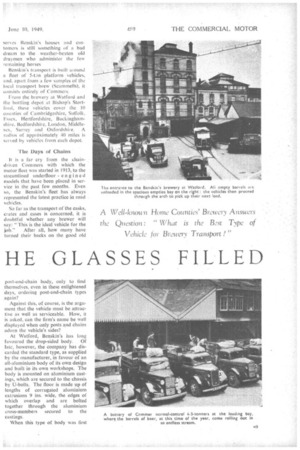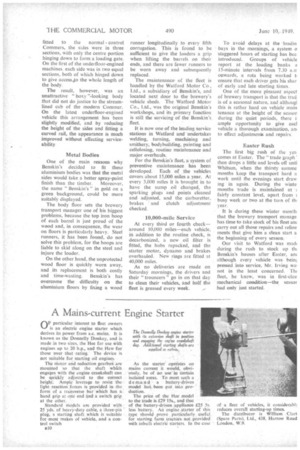KEEPIN
Page 16

Page 17

Page 18

If you've noticed an error in this article please click here to report it so we can fix it.
HE GLASSES FILLED
0 the casual observer, brewery transport is one of the " plum" assignments in the industry. It is a comparatively "clean" job, orderly and of even tenor; it is entirely lacking in all the helterskelter and confusion that are unavoidably present in many other sections Yet for all its advantaes there is another side of the picture, showing that life for the transport manager of a brewery is not, as might be imagined, all " beer and sk ittles." • For example, there is the old wrangle as to which is the best type
of vehicle for the brewery. The transport manager is concerned mainly with the practicability of Vehicles, whereas to the brewery owner they are mobile advertise-. ments-they must "look nice:' Then there are the empties—probably the transport man's biggest problem. Should -they *be picked up as the vehicle makes its rounds, or should they be collected on the return trip, regardless of dead mileage?
These are some of the difficulties in the life of the transport manager of a brewery. They are typical of those facing Mr W J. Irving, wh is responsible for the modern flei , of vehicles operated by Be.nskin (Watford) Brewery, Ltd.
The company, as such, is a con parative newcomer to the trade, ft it was incorporated only 50 yea] ago—the actual jubilee was eels brated last year. But the brewer itself is, perhaps, one of the olde: in existence; as the Cannon Brewer! it can be traced back to 1750.
With the transport, however, a with the company, great change have taken place in the past 50 yean and the modern fleet which no' serves Benskin's houses and customers is still something of a bad dream to the weather-beaten old draymen who administer the few remaining horses Benskin's transport is built around a fleet of '5-tan platform vehicles, and, apart from a few samples of the local transport brew tScammells), it consists entirely of Commers.
From the brewery at Watford and the bottling depot at Bishop's Stortford, these vehicles cover the 10 counties of Cambridgeshire, Suffolk, Essex, Hertfordshire, Buckinghamshire. Bedfordshire, London, Middlesex, Surrey and Oxfordshire. A radius of approximately 40 miles is served by vehicles from each depot.
The Days of Chains It is a far cry from the chaindriven Commers with which the motor fleet was started in 1913, to the streamlined underfloor engine cl models that have been placed in service in the past few months. Even so, the Benskin's fleet has always represented the latest practice in road vehicles.
So far as the transport of the casks, crates and .cases is concerned, it is doubtful whether any brewer will say: "This is the ideal vehicle for the job." After all, how many have turned their backs on the good old post-and-chain body, only to find themselves, even in these enlightened days, ordering post-and-chain types again?
Against this, of course, is the argument that the vehicle must be attractive as Well as serviceable. How, it is asked, can the firm's name be well displayed when only posts and chains adorn the vehicle's sides?
At Watford, Benskin's has long favoured the drop-sided body. Of late, however, the company has discarded the standard type, as supplied by the manufacturer, in favour of an all-aluminium body of its own design and built in its own workshops. The body is mounted on aluminium castings, which are secured to the chassis by U-bolts. The floor is made up of lengths of corrugated aluminium extrusions 9 ins, wide, the edges of which overlap and are bolted together through the aluminium cross-members secured to the castings.
When this type of body was first fitted to the normal control
Commers, the sides were in three sections, with only the centre portion hinging down to form a loading gate. On the first of the underfloor-engined machines, each side was in two equal sections, both of which hinged down to give access,to the whole length of the body.
The result, however, was an unattractive "boxy "-looking body that did not do justice to the streamlined cab of the modern Cominer. On the latest underfloor-engined vehicle this arrangement has been slightly modified, and by reducing the height of the sides and fitting a curved rail, the appearance is much improved without affecting serviceability Metal Bodies
One of the main reasons why Benskin's decided to fit these aluminium bodies was that the metal sides would take a better spray-paint finish than the timber. Moreover, the name " Benskin's " in gold on a green background, could be more suitably displayed.
The body floor sets the brewery transport manager one of his biggest problems, because the top iron hoop of each barrel is just proud of the wood and, in consequence, the wear on floors is particularly heavy. Steel runners, it has been found, do not solve this problem, for the hoops are liable to skid along on the steel and injure the loader.
On the other hand, the unprotected wood floor is quickly worn away, and its replacement is both costly and time-wasting. Benskin's has overcome the difficulty on the aluminium floors by fixing a wood runner longitudinally to every fifth corrugation. This is found to be sufficient to give the loaders a grip when lifting the barrels on their ends, and there are fewer runners to be worn away and subsequently replaced.
The maintenance of the fleet is handled by the Watford Motor Co , Ltd., a subsidiary of Benskin's, and located next door to the brewery's vehicle sheds. The Watford Motor Co., Ltd., was the original Benskin's workshops, and its primary function is still the servicing of the Benskin's fleet.
It is now one of the leading service stations in Watford and undertakes welding, turning, machining and smithery, bodybuilding, painting and cellulosing, routine maintenance and major overhauls.
For the Benskin's fleet, a system of preventive maintenance has been developed. Each of the vehicles covers about 15,000 miles a year. At every 3,000 miles it is brought in to have the sump oil changed, the sparking plugs and points cleaned and adjusted, and the carburetter, brakes and clutch adjustment checked.
10,000-mile Service
At every third or fourth check— around 10,000 miles—each vehicle, in addition to the routine check, is decarbonized, a new oil filter is fitted, the hubs repacked, and the starter motor, dynamo and brakes overhauled. New rings are fitted at 40,000 miles.
As no deliveries are made on Saturday mornings, the drivers and their " trouncers " go in on that day to clean their vehicles, and half the fleet is greased every week. To avoid delays at the tloadin bays in the mornings, a system 'staggered hours of starting has bee introduced, Groups of vehicle report at the . loading banks a 15-minute intervals from 730 auonwards, a rota being worked ti ensure that each driver gets his shat of early and late starting times.
One of the more pleasant aspect of brewery transport is that the trad is of a seasonal nature, and althougl this is rather hard on vehicle main tenance at the height of the season during the quiet periods, there ample opportunity to give cad vehicle a thorough examination, an to effect adjustments and repairs,
Easter Rush The fifst big rush of the yea comes at Easter, The "trade graph then drops a little and levels off unti Whitsun, when the thirsty summe months keep the transport hard a work until the evenings start draw ing in again. During the -winte months trade is maintained at fairly constant level, apart from E busy week or two at the turn of du year.
It is during these winter month, that the brewery transport manage has time to take stock of his fleet am carry out all those repairs and refine ments that give him a clean start a the beginning of every season.
Our visit to Watford was math during the rush to stock up tht Benskin's houses after Easter, am although every vehicle was beinz. pressed into service, Mr. Irving wa. not in the least concerned. Thu fleet, fleet, he knew, was in first-elas! mechanical condition—the seasor had only just started.


























